|
Moon with a View:
Or, What Did Arthur Know… and When Did He Know it?
Part 1
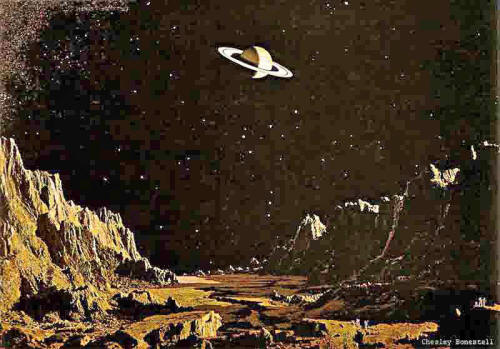
… the ship had long since passed the boundary set by outermost
Phoebe, moving backward in a wildly eccentric orbit eight million
miles from its primary. Ahead of it now lay Iapetus, Hyperion,
Titan, Rhea, Dione, Tethys, Enceladus, Mimas, Janus – and the rings
themselves. All the satellites showed a maze of surface detail …
Titan alone – three thousand miles in diameter, and as large as
Mercury – would occupy … months…
There was more; already he was certain that
Iapetus was his goal.
… One hemisphere of the satellite, which, like its companions,
turned the same face always toward Saturn, was extremely dark, and
showed very little surface detail. In complete contrast, the other
was dominated by a brilliant white oval, about four hundred miles
long and two hundred wide. At the moment, only part of this striking
formation was in daylight, but the reason for Iapetus’s
extraordinary variations in brilliance was now quite obvious ….
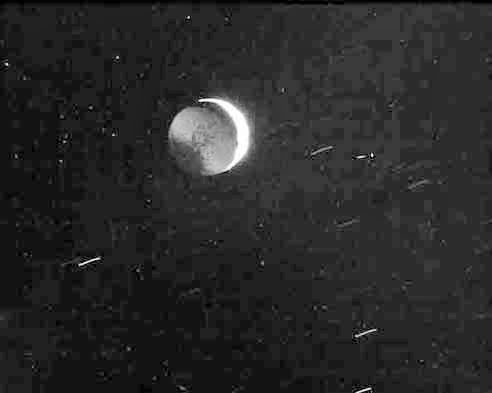
Those words -- written over forty years ago by my long-time friend,
Arthur C. Clarke -- describe the voyage of a lone, surviving
astronaut – David Bowman – to the ringed wonder of the solar system,
the planet Saturn, aboard a 21st Century spacecraft named
“Discovery.”
What Bowman discovers in the Saturn system – on an enigmatic moon
called “Iapetus” -- will forever change the Destiny of Humans ….
But, Arthur’s prophetic words could just as easily be describing the
current, equally astonishing 21st Century revelations of an unmanned
spacecraft called “Cassini,” exploring the latest baffling mysteries
Saturn …. In particular -- NOT the much ballyhooed, though recently
successful descent of Cassini’s Huygens probe to the surface of
Titan … Saturn’s largest satellite (whose results will be involved
later in our extraordinary tale …)
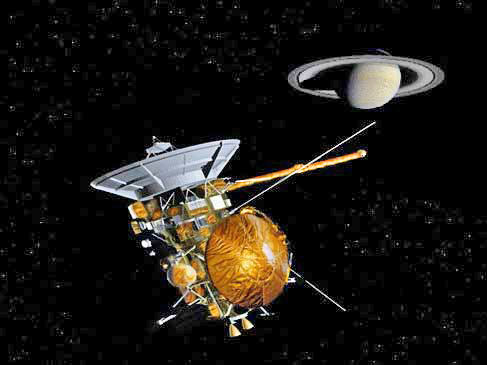
But Cassini’s far lesser known, far more haunting … (and to me) far
more significant—
Close-ups of Iapetus!
In 1965, when
Arthur began collaborating with the brilliant film
director, Stanley Kubrick, it was to bring their unique view of
Mankind’s most enduring mystery – “Where do we really come from …?”
– to the silver screen, in a way never seen before. They succeeded
... brilliantly.
The result was the immortal “2001: A Space Odyssey.”
Simultaneously, Arthur (C. Clarke) penned the “Saturn approach” scene we began
with (above), his own independent version of the same story --
a
novel – which, to some at least, has made portions of Stanley’s very
enigmatic “2001” perhaps a little more accessible (at least, certain
“transcendental” aspects of the film …).
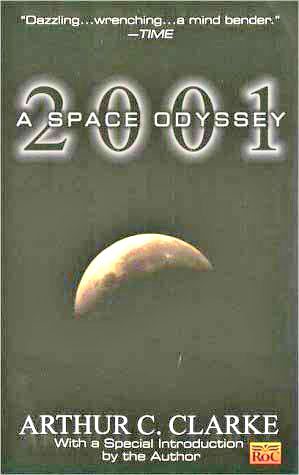
In Kubrick’s extravaganza, the climax comes when
David Bowman -- the
lone surviving astronaut of the deep space expedition, sent by a
future “NASA” in search of the Force which, “godlike,” has somehow
repeatedly intervened in “the million plus year evolution of Mankind
…” – finally encounters the “Monolith” … a black enigmatic “door,”
in orbit around the giant planet Jupiter.
The Monolith turns out to be (among its other wonders) a “star gate”
– a literal doorway (which, of course, is why Kubrick cinematically
made it a door …) to other dimensions of space and time … and,
ultimately, the mysterious “Progenitors” of the Human Race itself.
When Bowman eventually falls through it, he enters the Star Gate’s
vast Hyperdimensional transport system, culminating in his own
ambiguous meeting with “the Progenitors” (or, at least as much of
them as they allow him to experience …), which results in his final
“transformation” and return to Earth … the latest agent in
Humanities continuing “managed evolution.”
In Arthur’s novel (removed from the pre-CGI, 1960’s limitations on
film “special effects” that even Stanley Kubrick had to live
with …),
the Monolith
is waiting much farther from the Sun … on one of
Saturn’s distant moons.
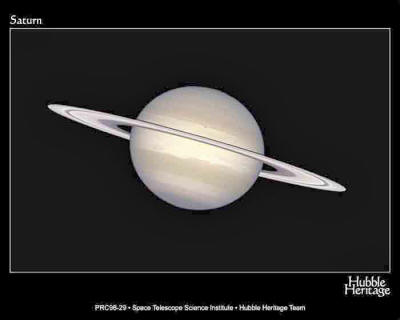
The same moon -- forty years after Arthur’s novel – I would contend,
which has now been revealed in Cassini’s latest images as..
THE MOST BAFFLING … BUT ARGUABLY,
THE SINGLE MOST IMPORTANT OBJECT
IN THE SOLAR SYSTEM ….
Iapetus [eye-AP-i-tus] is the seventeenth of Saturn's thirty three
currently known moons, and the third largest. It was named after a
Titan -- the son of Uranus and the father of Prometheus and Atlas
(the latter said to be the “fathers of Mankind”). Thus, in Greek
myth, Iapetus was also an ancestor … a progenitor… of “Homo Sapiens
Sapiens” ….
Iapetus was first seen via telescope by
Jean-Dominique Cassini, in
1671.

Iapetus’ actual name, however, was only given to it a hundred and
seventy six years after it was first seen by Cassini (who merely
referred to it, and the other three star-like objects he also
discovered circling Saturn, as “Lodicea Sidera” --“the stars of
Louis” -- in honor of France’s King Louis XIV, who had appointed him
France’s “chief astronomer”).
The current names of Saturn’s major moons, taken from a group of
“superbeings” in Greek myth called “Titans,” were given them by
Sir
John Herschel, in 1847. Herschel’s nomenclature for Iapetus and the
other six (then) known moons, was based on the logical association
of Saturn (“Cronus” in Greek) with the Titans; Herschel, continuing
the ritual, named the largest Saturnian moon “Titan” itself – in
honor of the entire pantheon.
Speaking of names: Cassini would go on to eventually discover the
largest “gap” in Saturn’s splendid, bewilderingly complex rings,
five years after discovering Iapteus … in 1676. This was later
appropriately named after its own discoverer – the “Cassini
Division” (below, under spacecraft). It is, of course, because of
Cassini’s record of several major astronomical discoveries at
Saturn, that the current unmanned Saturn mission is so-named ….
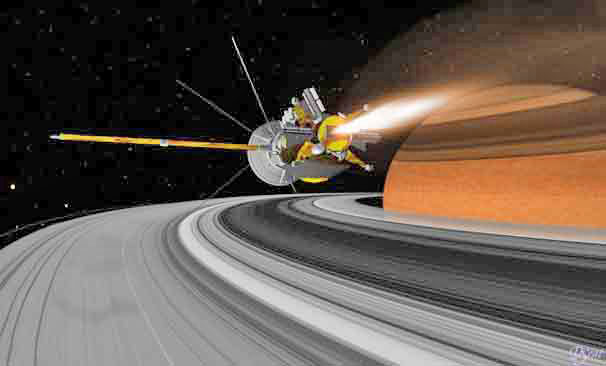
Iapetus’ most singular characteristic is the fact that, in Cassini’s
small, 17th century refracting telescope (it only had an objective
lens two inches in diameter!), the faint Saturnian moon (about 100
times dimmer than the faintest object visible to the unaided naked
eye) seemed to literally disappear about every 40 days … for half
its 79-day orbit!
As Cassini watched, Iapetus would be visible during its so-called
“western elongation” (when it was west of Saturn in the sky), but
would then progressively get dimmer as it curved around and passed
behind the planet, until it completely vanished as it approached
“eastern elongation.” Then, a few days later, it would “magically”
reappear … as an extremely faint “star” … growing steadily in
brightness, until it reached its farthest distance west of Saturn
once again and its greatest brightness!
This puzzling behavior would then mysteriously repeat -- like the
newly invented mechanical clockwork -- every 79 days; a mysterious
“winking” moon … orbiting Saturn … for as long as Cassini observed.
Although he was only capable of observing Iapetus in his small
telescope as a “dimensionless point of light,” Cassini correctly
theorized that this “winking moon” phenomenon had to be due to the
fact that one entire hemisphere of Iapetus must be vastly brighter
than the other half – and that the moon was synchronously rotating
(with one hemisphere continuously facing Saturn – like Earth’s Moon
always faces Earth) as Iapetus revolved around the distant ringed
planet in its 79-day orbit (below). If the leading hemisphere of
Iapetus was “very dark” Cassini theorized, and the trailing
hemisphere “remarkably bright,” this simple geometry would result in
the distant moon periodically falling below detectability in his
“modest glass …”
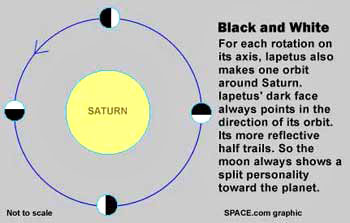
Three hundred ten years later – on November 14, 1980 -- the
NASA
Voyager 1 unmanned spacecraft transmitted, from only a few hundred
thousand miles away, the first clear image back to Earth showing
that Cassini had been right! Remarkably, the entire “front half” of
Iapetus was fully ten times darker than the “back half” – the former
reflecting only about as much light as a piece of charcoal … or (as
Arthur
put it in “2001”) burnt toast!
The geometry of this inexplicable dichotomy also proved unique
(below): for obvious reasons, Iapetus forever earned the
title that evening, after Voyager’s historic first fully resolved
images were sent home, of....
“The Yin/Yang Moon” ….
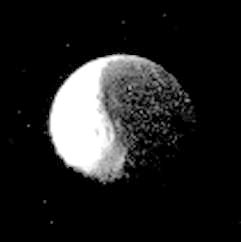
… At last, the pale dawn lay ahead; the ship, moving more and more
slowly now, was emerging into day. It could no longer escape from
the Sun, or even from Saturn – but it was still moving swiftly
enough to rise away from the planet until it grazed the orbit of
Iapetus, two million miles out.
It would take Discovery fourteen days to make that climb, as she
coasted once more, though in reverse order, across the paths of all
the inner moons. One by one she would cut through the orbits of
Janus, Mimas, Enceladus, Tethys, Dione, Rhea, Titan, Hyperion …
worlds bearing the names of gods and goddesses who had vanished only
yesterday, as time was counted here.
Then she would meet Iapetus, and must make her rendezvous ….

Voyager acquired many images as it approached Iapetus for the first
time. On some of them (below - left), a large (~ 150 mile diameter),
dark, ring-shaped feature appeared on the side of the moon facing
Saturn. In the center of the ring -- almost exactly as Arthur (C.
Clarke) had
described it before anyone could have seen it -- was an “elliptical
white region … with a black center!”

Arthur later reported that our mutual friend and colleague, the late
Carl Sagan -- who was one of the Voyager imaging team members – some
time after the first Iapetus encounter, sent him one of these
remarkable photos (above) … along with a note:
“Thinking of you ….”
In these first fascinating images, tangent to this giant ring
(above) – in fact, appearing to emanate from it in some kind of
“directed spray pattern!” -- was the far larger, extremely dark,
elliptical feature which appeared to cover the entire “front” of
this exotic moon. This was strikingly confirmed by a somewhat closer
shot, taken in approximate natural color by the follow-on Voyager 2
spacecraft (and, of the opposite side of the moon -- the one facing
away from Saturn) … in August, 1981 (below).
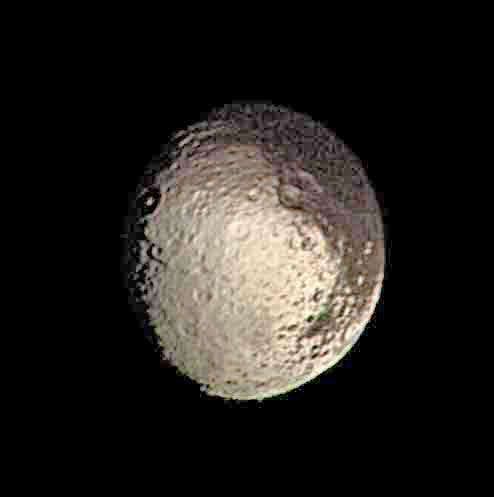
Another, closer shot -- this time, of the
Saturn side of Iapetus
again, from the current Cassini mission (below). Imaged by Cassini’s
much superior solid-state cameras, in July, 2004, the view confirms
Voyager’s remarkable first impressions ….
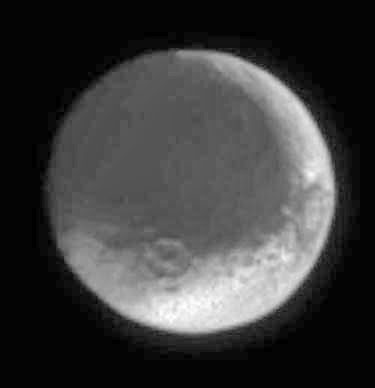
Mercator projection maps (below), created from images secured during
both Voyager fly-bys (the black regions are areas not covered by
either spacecraft), confirm this remarkable geometric aspect of “the
dark side of Iapetus”: the extraordinarily dark region traces an
almost exact elliptical pattern on the “front” of this increasingly
bizarre moon ….
But the cause if this unique, geometric “two-toned” surface was
still as mysterious after the two historic Voyager encounters … as
before.
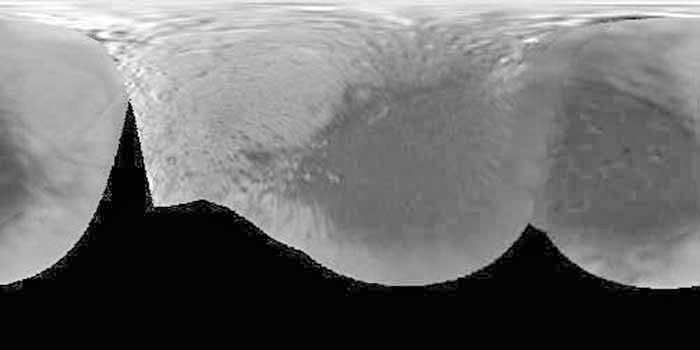
Thus, it was with some anticipation that those of us who were lucky
enough to be at JPL (Jet
Propulsion Laboratory) the night of the first Voyager Iapetus images
twenty five years ago, looked forward a few weeks ago to the closest
fly-by of Iapetus to date – to be accomplished by the Cassini
spacecraft, on New Year’s Eve, 2004.
Passing as close at 40,000 miles, and with cameras orders of
magnitude superior to Voyagers’, the results of the December 31,
2004
Cassini imaging did not disappoint: not only do the details
surpass all prior expectations … they reveal even deeper mysteries
surrounding this increasingly exotic moon ….
The distant images immediately confirmed one curious impression left
from the Voyager encounters of a quarter century before: in addition
to its other unique characteristics, Iapetus does not seem to be a
perfectly round moon!
A comparison with a real sphere (below-right) reveals that, from
this angle, Iapetus is visibly “squashed” -- by something like 50
miles out of its 900, or about 5%. For solid rocky bodies larger
than a few hundred miles across, the relentless force of gravity
always overcomes the innate tensile strength of such materials, and
forces them to assume a spherical geometry. For solid icy bodies
(those possessing less tensile strength), the limiting size before a
sphere is formed is even smaller.
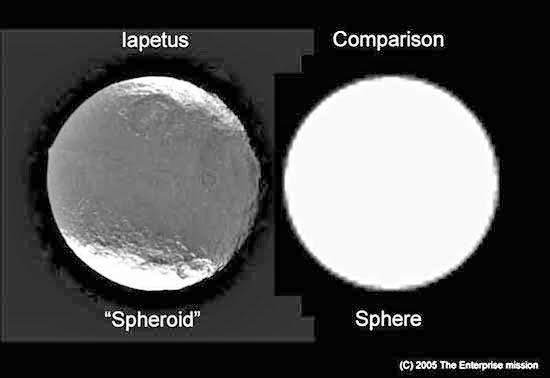
The key to defining this upper “roundness” limit lies in remotely
determining a moon’s “specific gravity,” which will in turn reveal
its average composition.
The means of doing this via an orbiting or passing spacecraft, is by
optically measuring the object’s diameter (from images), then
comparing that to its overall mass (derived from observing the
effect of its gravitational field on the spacecraft’s trajectory).
This mass determination, divided into the optical diameter, then
gives the average density of the object – which, in turn, can narrow
down its potential composition.
Earth’s Moon, for example, has an average density of “3.34” (3.34
times a similar-sized sphere composed of water) – revealing it to be
composed primarily of much denser “silicates” … a rocky object.
Thus, at 2160 miles across, despite the significant tensile strength
of “rocks,” the Moon’s own gravity has crushed it down to almost a
perfect sphere, as seen from Earth.
For Iapetus, Voyager’s measured density (via the techniques
described above) is about 1.21 – clearly only slightly denser than
an equal sized body made of water (there were obviously a few rocky
“impurities” incorporated into Iapteus during in its formation,
slightly increasing its average density …). Because this solid,
mostly icy body measures almost 900 miles across, yet rotates only
once every 79 days, any equatorial “centrifugal force” is clearly
insignificant. Thus, this cannot be the source of Iapetus’ major
“out of roundness.”
Coupled with the density observations of Voyager (and now Cassini),
these simple calculations assure that Iapetus’ basic shape (not
counting pieces blown off by external comet impacts …) should be
essentially a perfect sphere. Several of Saturn’s significantly
smaller moons -- like Mimas and Enceladus -- although also icy
objects, are spheres ….
Clearly, for some important reason Iapteus is not.
Now, look again at the left-hand image of Iapetus (above). What’s
that “thing” ... sticking up twelve miles above the left-hand limb?
According to
NASA’s official description of this image, it reveals
in 3-D--
… a long narrow ridge that lies almost exactly on the equator of
Iapetus ….
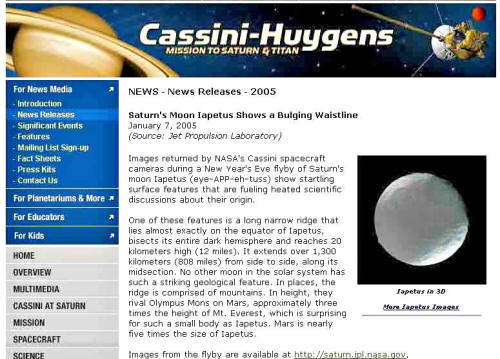
The release then goes on to say, with serious understatement:
… no other moon in the solar system has such a striking geological
feature ….
On color versions of the same image (below) -- created by
compositing three Cassini views taken through ultraviolet, green and
infrared filters – the contrast between the bizarre “chocolate
brown” of the leading hemisphere, and the brilliant white “polar
caps” north and south -- is particularly striking.
As is the presence of that baffling, arrow-straight, 12-mile-high
(~60,000 foot!) “wall” -- which precisely bisects the leading
hemisphere, and apparently crosses the entire width of this
strangely darkened “Cassini Regio” … over 800 miles in length.
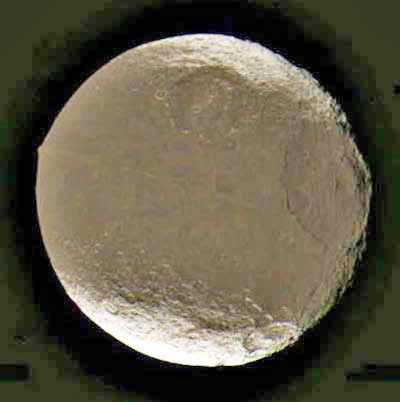
… for weeks, as it stared forever Sunward with its strange senses,
the Star Gate had watched the approaching ship. Its makers had
prepared it for many things, and this was one of them. It recognized
what was climbing up toward it from the warm heart of the Solar
System.
If it had been alive, it would have felt excitement, but such an
emotion was wholly beyond its powers. Even if the ship had passed it
by, it would not have known the slightest trace of disappointment.
It had waited three million years; it was prepared to wait for
eternity ….
There has hardly been an observer, viewing these astonishing new
Cassini images of Saturn’s strangest moon, who has not also thought
of
Arthur Clarke … and “2001.”
But some, after seeing the staggering equatorial feature now
girdling Iapetus, reached back even further into Arthur’s past, to
recall an earlier, equally prescient short story, called eerily—
“The Wall of Darkness.”
… In a universe consisting of one star and one planet, here is a
mysterious impenetrable wall surrounding the entire planet in the
deep freezing southlands. Two men, one with money, the other with
building skills, engage in a long-term program to scale the wall and
find out what's on the other side. The answer turns out to be …
rather upsetting …
In our opinion, Cassini’s discovery of “the Great Wall of Iapetus”
now forces serious reconsideration of a range of staggering
possibilities … that some will most certainly find … upsetting:
That, it could really be a “wall” …
a vast, planet spanning, artificial construct!!
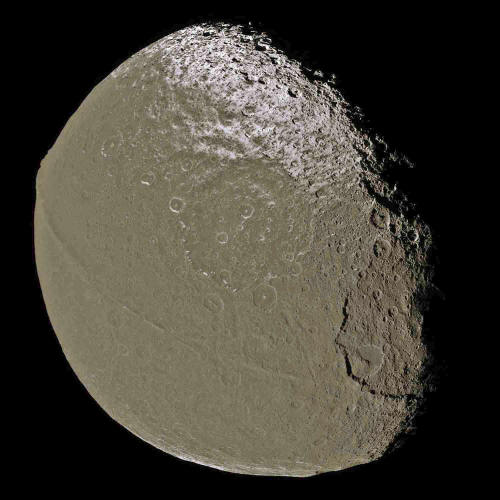
This is not the first time that startling new data has prompted
scientific consideration of “intelligence” at Saturn.
In addition to Arthur’s well-known musings, the extreme albedo range
displayed by Iapetus prompted a sober suggestion in the 1980’s, that
“the brightness variations might be artificial.” Donald Goldsmith
and Tobias Owen (the latter, the NASA discoverer of “the face on
Mars!”) wrote of Iapetus in
The Search for Life in the Universe
(1980):
This unusual moon is the only object in the Solar System which we
might seriously regard as an alien signpost - a natural object
deliberately modified by an advanced civilization to attract our
attention [emphasis added] ….
However, now that Cassini has revealed to us unquestionably the
greatest linear feature in the solar system (below), such scientific
speculations take on added urgency – if, for no other reason --
because—
There is no viable geological model to explain a sixty
thousand-foot-high, sixty thousand-foot-wide, four million-foot-long
“wall” … spanning an entire planetary hemisphere … let alone,
located in the precise plane of its equator!
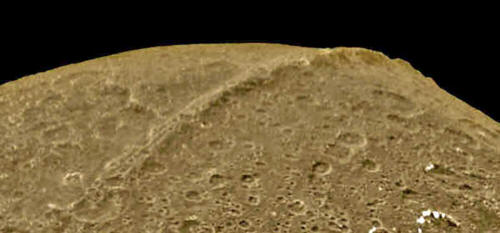
It is a well-known cliché that “Nature doesn’t usually create
straight lines.” If that is true, then it certainly doesn’t create
three of them (close-up-below) – all running parallel, not only to
each other, but to the literal equator of the planet.
“Nature” also doesn’t create a veritable “Maginot Line” of the
geometric complexity and regularity seen here … certainly not one
stretching horizontally, across this one small section of Iapetus,
for over sixty miles ….
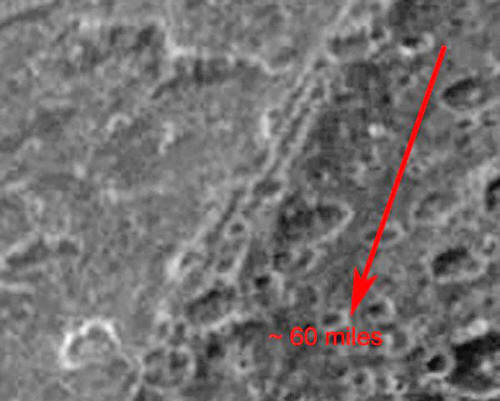
Therefore, ignoring for the moment “who” might have constructed such
an astounding edifice, and for “what reason,” the most important
question at this stage is simply:
“Is it feasible? Could a literal wall --
12 miles high … and 12
miles wide -- be technologically constructed on Iapetus?!”
The short answer is: yes.
The largest skyscraper currently planned for Earth is soon to be
completed in
the oil-rich kingdom of Dubai. The massive structure
(below), assembled with conventional concrete and steel but in a
“buttressed core configuration,” will reach an unprecedented height
of 2312 feet when completed, projected for sometime in 2008!

Scaled according to the surface gravity of Iapetus –
which is only
1/40th the strength of the surface gravity of Earth!
– a similar
skyscraper on the 900-mile-wide moon of Saturn could reach up 15
miles.
A “wall-like” structure -- as wide as it is tall – because of strong
lateral support, could reach far higher in such a weak gravity
field.
So, even with “conventional” building materials common in the early
21st Century on Earth, constructing the “Great Wall of Iapetus”
poses no significant theoretical problems (except for the money, of
course!). And, for any advanced “extraterrestrial materials” (nanotubes,
carbon fibers, zero-gravity crystalline titanium and steel, etc. …)
the practical problems in constructing even such a structure as the
“Great Wall” … would be trivial. Especially--
If armies of computer-controlled, robotic construction “workers” (or
even more advanced versions, billions of nanobots) were involved ….
Once this shocking idea (and the even more astounding Cassini
evidence …) has been properly assimilated – that this extraordinary
feature on Iapetus could be a manufactured artifact -- other,
equally geometric, non-natural anomalies begin to emerge across the
moon’s exotic two-toned surface (inset, below)!
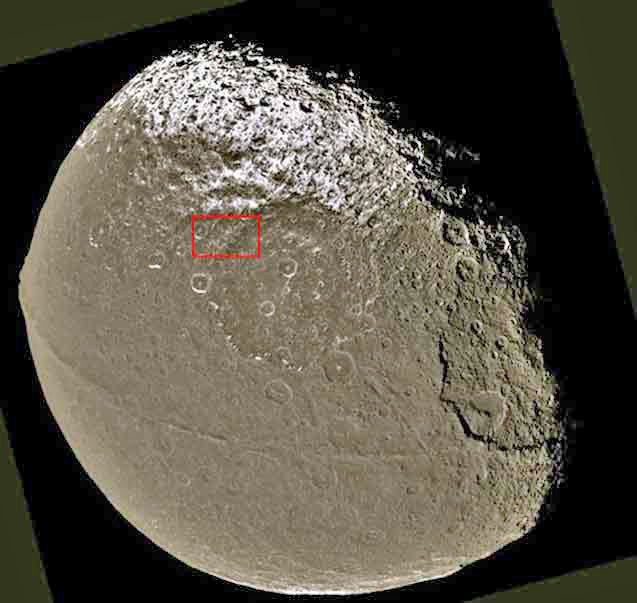
In this inset (below) is a striking set of clearly defined,
astonishing, repeating, three-dimensional rectilinear surface
patterns -- imaged in color and located several hundred miles north
of the Wall … near the boundary between the “brown stuff” and the
“white stuff” on the leading hemisphere of Iapetus (sunlight from
bottom left).
The rectilinearities run precisely north/south, east/west ….
Clearly these are NOT random, “square craters” -- but remarkable,
highly ordered evidence of sophisticated, aligned, repeating
architectural relief!
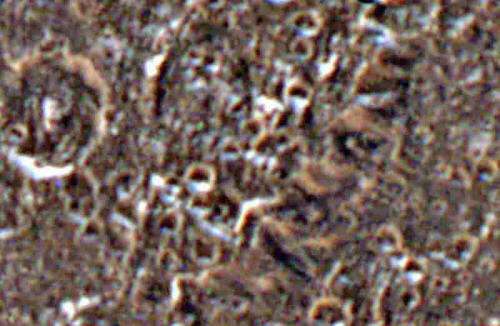
A close-up (below) amply confirms this first impression. Note the
“standard-width,” right-angle walls, and the dozens of “box-like”
rooms and buildings contained within those walls ….
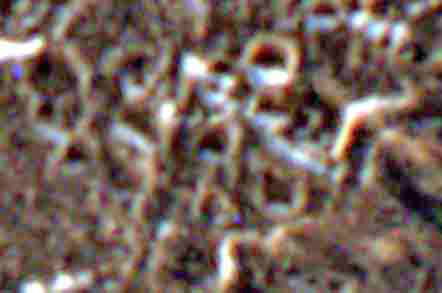
Close-ups from other sections of this “transitional terrain” (just
west of this image - below) reveal more of this astonishing, three-D
“honeycombing.” Note the aligned edges of the hundreds of “square”
holes in this image … and, again, more repeating, right-angle,
uniform-width “walls.” Here, the repeating, rectilinear geometry
appears to be “mantled” with a heavy “snowfall” ….
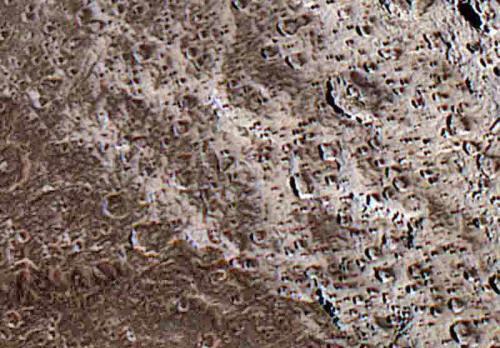
Here (below), are two close-up sections of the previous image.
The enlargement on the left features a square opening, apparently
looking deep below the surface … into a rectangular underground
tunnel with multiple, geometric “levels.”
The close-up on the right shows an equally obvious, multi-storied,
rectangular structure -- flanked on three 90-degree sides by concave
“stadium-like” features … with a, roofless, lattice-like “building”
on the right of the central rectangle.
Smaller, equally geometric and carefully aligned “box-like openings”
appear farther away ….
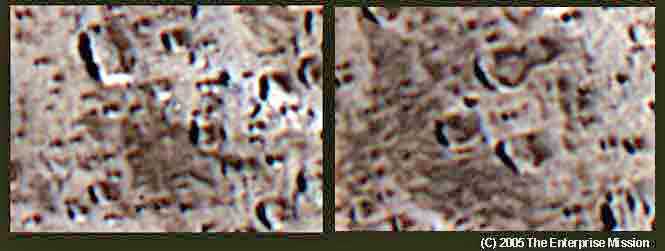
The impression of a vast set of extremely ancient ruins – most now
without roofs, but with ample surviving walls – covered both by
“snow” … and whatever the “brown stuff” is … is unavoidable.
If the idea of a massive, artificial “wall” girdling this satellite
is difficult to swallow, the existence of thousands of square miles
of clearly rectilinear ruins on the same airless, icy satellite is
definitely “over the top.”
So, let’s examine some more evidence ….
Here (below) is a
wide angle Cassini color image, taken of the
northern “polar ice” and terminator. At top center (red outline) is
an area where the spacecraft is looking almost horizontal to the
local surface.
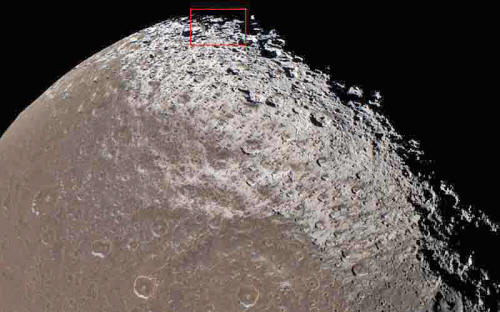
In close-up (below), the intensely angular -- and repetitive --
vertical architectural geometry, and rectilinear design extending
across this entire region, is unmistakable … and totally
“unnatural.”

Confirmation that “something” (besides the astonishing
equatorial
“wall”) is extending miles into space – here, above the polar
regions of this 900-mile-wide moon (below) -- can be seen in this
equatorial
low-res approach color image -- taken by
Cassini at
approximately 500,000 miles, on December 26, 2004.
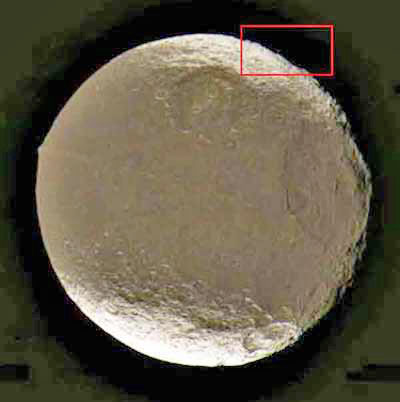
Note (close-up, below) the string of bright, reflecting objects --
hanging (somehow …) well above the satellite’s limb ….

Then, if we look along the southern horizon, we see the same type of
anomaly … this time a “tower-like structure,” rising more than a
mile above the surrounding terrain (below)
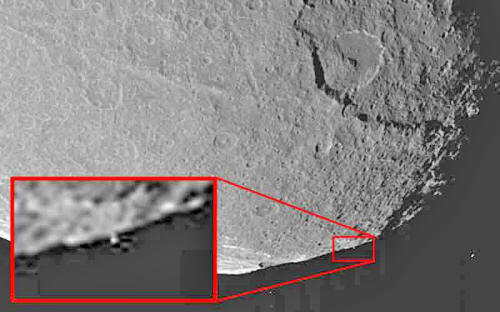
Above it lies a remarkably geometric “waffle pattern” – more
evidence that all on Iapetus is not quite “natural.”
All pointing toward an equally “unnatural,” if not extraordinary
explanation for this “moon” ….
What the hell did Arthur know … and “how?!”
Click Here for Part Two
→
|






























